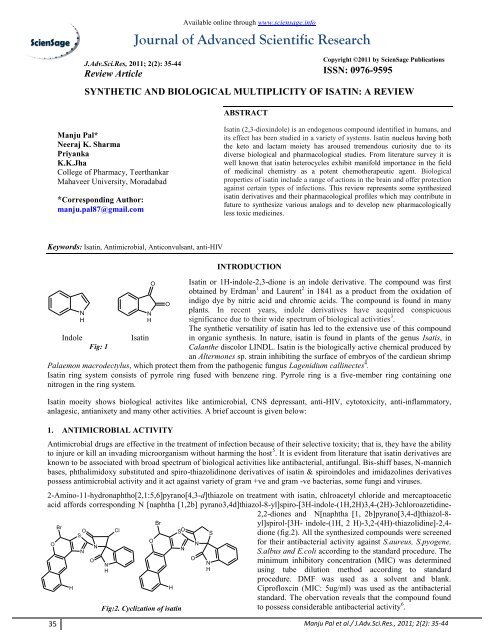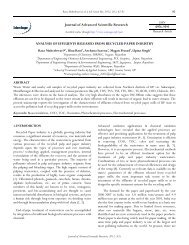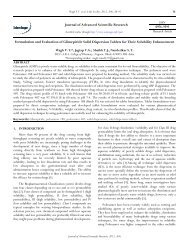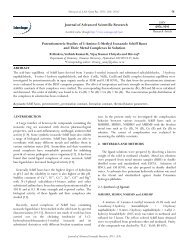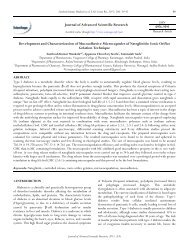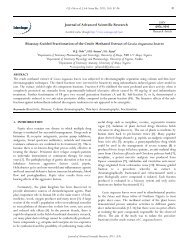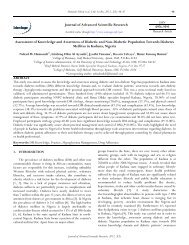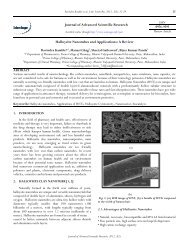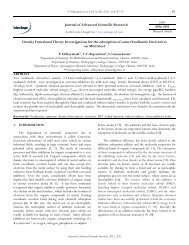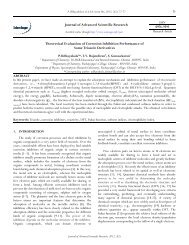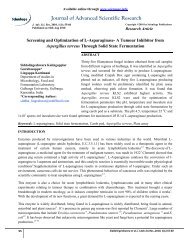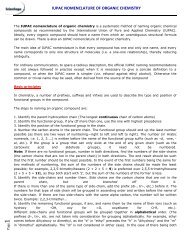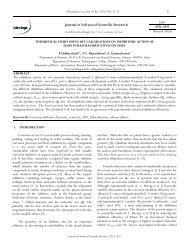synthetic and biological multiplicity of isatin: a review - Sciensage.info
synthetic and biological multiplicity of isatin: a review - Sciensage.info
synthetic and biological multiplicity of isatin: a review - Sciensage.info
Create successful ePaper yourself
Turn your PDF publications into a flip-book with our unique Google optimized e-Paper software.
Available online through www.sciensage.<strong>info</strong><br />
Journal <strong>of</strong> Advanced Scientific Research<br />
J.Adv.Sci.Res, 2011; 2(2): 35-44<br />
Review Article<br />
Copyright ©2011 by ScienSage Publications<br />
ISSN: 0976-9595<br />
SYNTHETIC AND BIOLOGICAL MULTIPLICITY OF ISATIN: A REVIEW<br />
ABSTRACT<br />
Manju Pal*<br />
Neeraj K. Sharma<br />
Priyanka<br />
K.K.Jha<br />
College <strong>of</strong> Pharmacy, Teerthankar<br />
Mahaveer University, Moradabad<br />
*Corresponding Author:<br />
manju.pal87@gmail.com<br />
Isatin (2,3-dioxindole) is an endogenous compound identified in humans, <strong>and</strong><br />
its effect has been studied in a variety <strong>of</strong> systems. Isatin nucleus having both<br />
the keto <strong>and</strong> lactam moiety has aroused tremendous curiosity due to its<br />
diverse <strong>biological</strong> <strong>and</strong> pharmacological studies. From literature survey it is<br />
well known that <strong>isatin</strong> heterocycles exhibit manifold importance in the field<br />
<strong>of</strong> medicinal chemistry as a potent chemotherapeutic agent. Biological<br />
properties <strong>of</strong> <strong>isatin</strong> include a range <strong>of</strong> actions in the brain <strong>and</strong> <strong>of</strong>fer protection<br />
against certain types <strong>of</strong> infections. This <strong>review</strong> represents some synthesized<br />
<strong>isatin</strong> derivatives <strong>and</strong> their pharmacological pr<strong>of</strong>iles which may contribute in<br />
future to synthesize various analogs <strong>and</strong> to develop new pharmacologically<br />
less toxic medicines.<br />
Keywords: Isatin, Antimicrobial, Anticonvulsant, anti-HIV<br />
N<br />
H<br />
Indole<br />
Fig: 1<br />
Isatin<br />
N<br />
H<br />
INTRODUCTION<br />
Isatin or 1H-indole-2,3-dione is an indole derivative. The compound was first<br />
obtained by Erdman 1 <strong>and</strong> Laurent 2 in 1841 as a product from the oxidation <strong>of</strong><br />
indigo dye by nitric acid <strong>and</strong> chromic acids. The compound is found in many<br />
plants. In recent years, indole derivatives have acquired conspicuous<br />
significance due to their wide spectrum <strong>of</strong> <strong>biological</strong> activities 3 .<br />
The <strong>synthetic</strong> versatility <strong>of</strong> <strong>isatin</strong> has led to the extensive use <strong>of</strong> this compound<br />
in organic synthesis. In nature, <strong>isatin</strong> is found in plants <strong>of</strong> the genus Isatis, in<br />
Calanthe discolor LINDL. Isatin is the <strong>biological</strong>ly active chemical produced by<br />
an Altermones sp. strain inhibiting the surface <strong>of</strong> embryos <strong>of</strong> the cardiean shrimp<br />
Palaemon macrodectylus, which protect them from the pathogenic fungus Lagenidium callinectes 4 .<br />
Isatin ring system consists <strong>of</strong> pyrrole ring fused with benzene ring. Pyrrole ring is a five‐member ring containing one<br />
nitrogen in the ring system.<br />
Isatin moeity shows <strong>biological</strong> activites like antimicrobial, CNS depressant, anti-HIV, cytotoxicity, anti-inflammatory,<br />
anlagesic, antianixety <strong>and</strong> many other activities. A brief account is given below:<br />
1. ANTIMICROBIAL ACTIVITY<br />
O<br />
O<br />
Antimicrobial drugs are effective in the treatment <strong>of</strong> infection because <strong>of</strong> their selective toxicity; that is, they have the ability<br />
to injure or kill an invading microorganism without harming the host 5 . It is evident from literature that <strong>isatin</strong> derivatives are<br />
known to be associated with broad spectrum <strong>of</strong> <strong>biological</strong> activities like antibacterial, antifungal. Bis-shiff bases, N-mannich<br />
bases, phthalimidoxy substituted <strong>and</strong> spiro-thiazolidinone derivatives <strong>of</strong> <strong>isatin</strong> & spiroindoles <strong>and</strong> imidazolines derivatives<br />
possess antimicrobial activity <strong>and</strong> it act against variety <strong>of</strong> gram +ve <strong>and</strong> gram -ve bacterias, some fungi <strong>and</strong> viruses.<br />
2-Amino-11-hydronaphtho[2,1:5,6]pyrano[4,3-d]thiazole on treatment with <strong>isatin</strong>, chlroacetyl chloride <strong>and</strong> mercaptoacetic<br />
acid affords corresponding N [naphtha [1,2b] pyrano3,4d]thiazol-8-yl]spiro-[3H-indole-(1H,2H)3,4-(2H)-3chloroazetidine-<br />
O<br />
Br<br />
H<br />
O<br />
S<br />
N<br />
O<br />
N<br />
N<br />
H<br />
Cl<br />
O<br />
Br<br />
SO<br />
Fig:2. Cyclization <strong>of</strong> <strong>isatin</strong><br />
H<br />
N<br />
O<br />
N<br />
S<br />
N<br />
H<br />
2,2-diones <strong>and</strong> N[naphtha [1, 2b]pyrano[3,4-d]thiazol-8-<br />
yl]spirol-[3H- indole-(1H, 2 H)-3,2-(4H)-thiazolidine]-2,4-<br />
dione (fig.2). All the synthesized compounds were screened<br />
for their antibacterial activity against S.aureus, S.pyogene,<br />
S.albus <strong>and</strong> E.coli according to the st<strong>and</strong>ard procedure. The<br />
minimum inhibitory concentration (MIC) was determined<br />
using tube dilution method according to st<strong>and</strong>ard<br />
procedure. DMF was used as a solvent <strong>and</strong> blank.<br />
Cipr<strong>of</strong>loxcin (MIC: 5ug/ml) was used as the antibacterial<br />
st<strong>and</strong>ard. The obervation reveals that the compound found<br />
to possess considerable antibacterial activity 6 .<br />
35 Manju Pal et al./ J.Adv.Sci.Res., 2011; 2(2): 35-44
Available online through www.sciensage.<strong>info</strong><br />
G L Talesara 7 et al had been synthesized 3'-[(4-acetate phenyl-1N-ethoxyphthalimido-6'-pyridin-2-yl]-3,3a'-dihydro-6'Hspiro<br />
[indole-3,5'-[1,3]-thiazole[4,5-c]isoxazol]-2(1H)-ones (fig. 3) by reacting 3-(4-acetate phenyl)-6-pyridin-2-yl-3,3adihydro-6H-spiro[indole-3,5[1,3]thiazolo[4,5-c]isoxazol]-2(1H)<br />
-ones with bromoethoxypthalimide which shows good<br />
antimicrobial activity.<br />
5-substituted-3-(4-arylimino)-1-[5-mercapto(1,3,4-oxadiazolyl)]<br />
-methyl-indol-2-one (fig. 4) have been synthesized by<br />
heterocyclization <strong>of</strong> 5-substituted-3-(4-arylimino)-2-oxo-1-<br />
indole acetylhyrazide on treatment with CS 2 in ethanolic KOH.<br />
All the compounds were evaluated for their in-vitro antibacterial<br />
activity against S. aureus NCIM 2079, B subtilis ATCC<br />
6633, E. coli ATCC M 200, P. vulgaris NCIM 2813 <strong>and</strong> antifungal<br />
against C. albicans NCIM 3471, A. niger NCIM 545<br />
st<strong>and</strong>ard strains using disc diffusion method. The synthesized<br />
compounds showed good antibacterial <strong>and</strong> antifungal activity 8 .<br />
Ali Asghar Jarrahpour 9 et al had been synthesized bis-Schiff<br />
bases <strong>of</strong> <strong>isatin</strong> by condensation <strong>of</strong> <strong>isatin</strong>, benzyl<strong>isatin</strong> <strong>and</strong> 5-<br />
fluoro<strong>isatin</strong> (fig.5) with primary aromatic amines which posses<br />
significant antiviral, antibacterial <strong>and</strong> antifungal actvity.<br />
H 3 CO<br />
O<br />
R 1<br />
N<br />
S<br />
N<br />
N<br />
O<br />
N<br />
Fig:3. Cyclocondensation <strong>of</strong> <strong>isatin</strong><br />
N<br />
N<br />
O<br />
O<br />
O<br />
R<br />
N<br />
O<br />
R<br />
N<br />
N<br />
H<br />
CH 3<br />
O O<br />
N<br />
N<br />
H<br />
Fig:5. bis-Shiff bases <strong>of</strong> <strong>isatin</strong><br />
N<br />
N<br />
H<br />
O<br />
NH<br />
O<br />
N<br />
O<br />
N<br />
Fig:6. Isatin derivatives<br />
3-[(5-benzylidene-2-phenyl)-3,5-dihydro-4-H-imidazol-<br />
4-one -3-(4-bezoylhydrazono)]-indole-2-ones(fig.6)were<br />
sythesized by Sanjay Bari 10 <strong>and</strong> coworkers which is<br />
reacted by <strong>isatin</strong> hydrazones (II, 0.01 mol) <strong>and</strong> 2-phenyl<br />
5-bezylidene 3N (4-acetyl phenyl)-1,5-dihydroimidazole-4-one<br />
which shows promising antimicrobial activity.<br />
R S Verma 11 et al had been synthesized 2-[(3-chloro-2-<br />
phenyl)-4-azetidinon-3yl]-1,3,4-thiadiazinol[6,5-b]indole<br />
(fig.7) by reacting benzyliden amino-1,3,4-<br />
thiadiazione[6,5-b]indole <strong>and</strong> chloroacetyl chloride. The<br />
compounds were evaluated for their antimicrobial<br />
susceptibility test against S.aureus,E.coli, K.pneumoniae,<br />
P.vulgaris, A.fumigatus, C.albicans, albicans ATCC,<br />
C.krusei G03 respectively. The compounds showed<br />
significant antibacterial <strong>and</strong> antifungal activity.<br />
G L Teralesara 12 et al had been synthesized 3'{4(1acetyl-5(4-flurophenyl)-2pyrazoline-3yl)phenyl} 1-N-ethoxyphthalimido-<br />
4'-spiro[indole-3,2'-[1,3]thiazolidene]-2,4'-1H-dione (fig. 8) which is formed by reacting 3{4-(1-acetyl-5-(4-chlorophenyl)-<br />
2pyrazoline-3-yl)phenyl}-4'H-spiro[indole-3,2'-[1,3]thiazolidene]-2,4'-1H-dione in DMF <strong>and</strong> sodium hydride which showed<br />
good antibacterial activity.<br />
N<br />
N<br />
O<br />
SH<br />
Fig:4. 5-substituted-3-(4-arylimino)-1-[5-mercapto (1,3,4<br />
-oxadiazolyl)]-methyl-indol-2-one analogs<br />
S<br />
O<br />
N<br />
O<br />
N<br />
N<br />
R<br />
N<br />
Cl<br />
N<br />
F<br />
N<br />
N<br />
N<br />
S<br />
O<br />
Fig:7. Isatin thiadiazino derivatives<br />
Fig:8. Phthalimidoxy substituted <strong>and</strong> spiro-thiazolidinone<br />
36 Manju Pal et al./ J.Adv.Sci.Res., 2011; 2(2): 35-44
Available online through www.sciensage.<strong>info</strong><br />
5-Nitro-1H-indole-2,3dione-3-N-(4H-methylphenyl)thiosemicarbazones (fig.9) were synthesized by Vikash Kumar 13 et al<br />
by reacting 3-hydrazono-5-nitro-1,3-dihydro-2H-indole-2-one <strong>and</strong> p-methyl phenylisothio cyanate. The compounds were<br />
screened for antibacterial activity against E.coli <strong>and</strong> S. aureus by Cup–plate method.<br />
Isatin <strong>and</strong> its chloro derivative had been reacted with 5-amino, 8-hydroxy-quinoline to from Shiff <strong>and</strong> the N-Mannich bases<br />
<strong>of</strong> <strong>isatin</strong> (fig. 10). Compounds were synthesized by reacting them with formaldehyde <strong>and</strong> several secondary amines.<br />
Investigation <strong>of</strong> antimicrobial activity <strong>of</strong> the compounds was made by the agar dilution method. The compounds are<br />
significantly active against bacteria <strong>and</strong> fungi 14 .<br />
R<br />
N<br />
H<br />
S<br />
N NH NH<br />
O<br />
R 1<br />
R 1<br />
N<br />
N<br />
N<br />
R<br />
O<br />
OH<br />
Fig:9. Isatin thiosemicarbazone derivatives<br />
Fig: 10. Hydroxyquinoline Schiff bases<br />
A series <strong>of</strong> schiff <strong>and</strong> mannich bases <strong>of</strong> <strong>isatin</strong> (fig. 11) had been synthesised by S K Singh 15 et al which is formed by<br />
dimethyl amine, diethyl amine, piperidine, morphine, pyrazinamide <strong>and</strong> formaldehyde <strong>and</strong> shows significant antimicrobial<br />
activity.<br />
1-(3-phenyl-spiro[3H-indole-3,2-thiazolidine]-2,4(1H)-dione-1-ylacetamido)-2-phenyl-4-phenyl-idene-5-oxoimidazolines<br />
(fig. 12) were formed by the mixture <strong>of</strong> 3-phenyl-spiro[3H-indole-3,2-thiazolidine]-2,4(1H)-dione-1-ylacetyl hydrazine <strong>and</strong><br />
2-phenyl-4-phenylidene-5-oxazolone in the presence <strong>of</strong> glacial acetic acid by U.C.Mashelkar 16 <strong>and</strong> coworkers. The<br />
synthesized compound shows good antibacterial activity.<br />
N-Mannich bases <strong>of</strong> <strong>isatin</strong> (fig. 13) were formed by U.K.Singh 17 <strong>and</strong> coworkers by reacting Schiff’s bases <strong>of</strong> Isatin with<br />
formaldehyde <strong>and</strong> secondary amine. The compounds show promising antimicrobial activity.<br />
S<br />
O<br />
NH NH<br />
N<br />
N<br />
N<br />
O<br />
R<br />
N<br />
O<br />
O<br />
S<br />
NH 2<br />
NH<br />
N<br />
O<br />
OC O<br />
NH<br />
N<br />
N<br />
R'<br />
R<br />
N<br />
O<br />
R 1<br />
N<br />
R 2<br />
N<br />
Fig:11. N-Mannich bases <strong>of</strong> <strong>isatin</strong> Fig:12. Spiroindoles <strong>and</strong> imidazolines derivaties Fig:13. N-Mannich bases <strong>of</strong> <strong>isatin</strong><br />
2. CNS DEPRESSANT ACTIVITY<br />
Depression is defined as disorders <strong>of</strong> mood rather than disturbances <strong>of</strong> thought or cognition. Depression accompanied by<br />
hallucination <strong>and</strong> delusion 18 . Some <strong>of</strong> <strong>isatin</strong> derivatives show CNS depressant activity. Semicarbazones, thiosemicarbazole,<br />
heterocyclic derivatives <strong>of</strong> <strong>isatin</strong> <strong>and</strong> Isatin-based spiroazetidinones shows anticonvulsant activity.<br />
S N P<strong>and</strong>ey 19 et al had been synthesized Isatin-3-hydrazone (fig. 14) by istain, parabromo <strong>and</strong> phenoxy acetyl hydrazide<br />
with glaceial acetic acid which shows anticonvulsant activity.<br />
Krishan N<strong>and</strong> Singh 20 et al had been synthesized (3Z)-5-bromo-1-methyl-3-[(4-nitrophenyl)imino]-1,3-dihydro-2H-indol-2-<br />
one (fig. 15) by reacting 5-substituted N-methyl/N-acetyl <strong>isatin</strong> <strong>and</strong> aromatic amine with glacial acetic acid <strong>and</strong> was shown<br />
to possess good anticonvulsant activity.<br />
37 Manju Pal et al./ J.Adv.Sci.Res., 2011; 2(2): 35-44
Available online through www.sciensage.<strong>info</strong><br />
O<br />
N NH R 1<br />
R<br />
N<br />
R 2<br />
R<br />
N<br />
H<br />
O<br />
N<br />
R 1<br />
O<br />
Fig:14. Semicarbazone <strong>isatin</strong> derivatives<br />
Fig:15. Shiff bases <strong>of</strong> <strong>isatin</strong> derivatives<br />
N-methyl/acetyl-5-(un)-substituted <strong>isatin</strong>-3-semicarbazones (fig. 16) were formed by Sivakumar Smith 21 <strong>and</strong> coworkers by<br />
reacting N-methyl/acetyl <strong>isatin</strong>, 5-bromo/nitro-N-acetyl <strong>isatin</strong> <strong>and</strong> p-substituted phenyl semicarbazides. The compounds<br />
possess anticonvulsant <strong>and</strong> sedative activity.<br />
Ashok Kumar 22 et al had been synthesized 3-Spiro[1', 3', 4'-oxa/thiadiazolyl-2'-{5''-(substitutedphenyl-3''-amino)-4'-{5''-<br />
(substituted phenylisoxazolinyl)}]-5'-indol-2-ones (fig. 17) by the reaction <strong>of</strong> 3-Spiro-[1', 3', 4'-oxadiazolyl-2'-{1''-acetyl-5''-<br />
(2-hydroxyphenyl-3''-amino)-4'-{1''-acetyl-5''- (2-hydroxyphenyl) pyrazolinyl}]-5'-indol-2-ones with methanol, hydroxyl<br />
amine <strong>and</strong> NaOH solution which shows anticovulsant <strong>and</strong> antipsycotic activity.<br />
R<br />
O<br />
x<br />
O N N<br />
N<br />
NH<br />
R<br />
N<br />
NH<br />
NH<br />
R<br />
X<br />
O<br />
N<br />
O<br />
R 1<br />
N<br />
O<br />
N<br />
H<br />
Fig:16. Thiosemicarbazole <strong>isatin</strong> derivatives<br />
Fig:17. Pyrazolinyl/isoxazolinyl indol-2-ones derivatives<br />
Heterocyclic derivatives <strong>of</strong> <strong>isatin</strong> (fig. 18) were formed by reacting a heterocyclic system like <strong>isatin</strong>/5-fluoro<strong>isatin</strong> with ethyl<br />
cyano acetate <strong>and</strong> substituted ketones which shows anticonvulsant activity 23 .<br />
3-aryloxyl, arylthioxy acetyl hydrazono-2-indolinones (fig. 19) had been synthesized by Gursoy <strong>and</strong> Karali 24 et al.<br />
Singh 25 et al had been synthesized a series <strong>of</strong> <strong>isatin</strong>-based spiroazetidinones (fig. 20) <strong>and</strong> screened them for their<br />
anticonvulsant activity.<br />
H 3<br />
COOC 2 H 5<br />
H 5 C 6 OC<br />
F<br />
C<br />
O<br />
N<br />
H<br />
NH 2<br />
O<br />
NNHC(S)NHR 2<br />
R 1 O<br />
N<br />
R<br />
H 5 C 6 O<br />
H 5 C 6<br />
N<br />
R<br />
N<br />
COCH(C 6 H 5 ) 2<br />
Fig:18. Heterocyclic derivatives <strong>of</strong> <strong>isatin</strong> Fig:19. Hydrazono-2-indolinones Fig:20. Isatin-based spiroazetidinones<br />
3-(-4-(4-hydroxy-3-methoxylbenzylideneamino) phenyl imino) indoline-2-one (fig. 21) was synthesized by the <strong>isatin</strong> <strong>and</strong> p-<br />
phenylenediamine by dissolving in sufficient quantity <strong>of</strong> methanol (30 mL) in the presence <strong>of</strong> acetic acid. Various aromatic<br />
aldehydes were allowed to react to obtain final compounds 26 . The compounds showed excellent anticovulsant activity.<br />
Isatin schiff’s bases (fig. 22) were formed by the 6-(un)substituted 1,3 benzothiazol-2-amine <strong>and</strong> indole 2, 3-dione by<br />
dissolving 20 ml <strong>of</strong> absolute alcohol <strong>and</strong> were refluxed in presence <strong>of</strong> few drops <strong>of</strong> glacial acetic acid 27 .<br />
Isatin-5-Sulphonamide derivatives (fig. 23) were formed by the M. Sarangapani 28 <strong>and</strong> the compounds were evaluated for<br />
anticonvulsant ability using Phenytion as st<strong>and</strong>ard. All the synthesized compounds showed excellent anticonvulsant activity<br />
against electric shock induced <strong>and</strong> Pentylenetetrazole induced seizures.<br />
38 Manju Pal et al./ J.Adv.Sci.Res., 2011; 2(2): 35-44
Available online through www.sciensage.<strong>info</strong><br />
N<br />
N<br />
H<br />
O<br />
N<br />
OCH 3<br />
OH<br />
R<br />
N<br />
S<br />
O<br />
N<br />
H<br />
N<br />
RO 2 S<br />
N<br />
H<br />
O<br />
O<br />
Fig:21.Phenylimino Shiff bases <strong>of</strong> <strong>isatin</strong> Fig:22. Isatin schiff bases Fig:23. Isatin-5-Sulphonamide derivatives<br />
3. CYTOTOXICITY<br />
Cancer is a disease characterised by uncontrolled multipication <strong>and</strong> spread <strong>of</strong> abnormal forms <strong>of</strong> the body’s own cells 18 .<br />
From literature survey it is well known that <strong>isatin</strong> heterocycles exhibit manifold importance in the field <strong>of</strong> medicinal<br />
chemistry as a potent chemotherapeutic agent. Bis-di<strong>isatin</strong> derivatives, Bis-Isatin Thiocarbohydrazone Metal Complexes, 3-<br />
o-Nitrophenyl hydrazones <strong>of</strong> <strong>isatin</strong> possess cytotoxicity activity.<br />
Co(II), Ni(II), Cu(II), <strong>and</strong> Zn(II) complexes <strong>of</strong> thiocarbohydrazone lig<strong>and</strong> (fig. 24) were formed by reacting with ethanolic<br />
solution <strong>of</strong> metal chloride or aqueous ethanolic solution <strong>of</strong> metal acetates with specific amount <strong>of</strong> the lig<strong>and</strong>. Compound<br />
shows antitumour activity 29 .<br />
Md. Arifuzzaman 30 et al had been synthesized Bis-di<strong>isatin</strong> [3,3´] furan (fig. 25) on treatment with furan in presence <strong>of</strong><br />
diethylamine under intensive stirring. The compounds were evaluated for cytotoxicity study on the brine shrimp as a test<br />
organism.<br />
H<br />
N<br />
HN<br />
N<br />
HN<br />
O<br />
CH 3<br />
N<br />
Cu<br />
S<br />
Cl<br />
. 2H 2<br />
0<br />
X<br />
O<br />
X<br />
O<br />
NH<br />
R<br />
O<br />
O<br />
N<br />
H<br />
R<br />
N<br />
H<br />
Fig:24. Bis-Isatin Thiocarbohydrazone Metal Complexes<br />
Fig:25. Bis-di<strong>isatin</strong> derivatives<br />
CH 3<br />
N<br />
CH 3<br />
O<br />
O<br />
R<br />
N<br />
N<br />
H<br />
NH<br />
O NO 2<br />
Br<br />
H 3 C<br />
N<br />
N<br />
N<br />
CH 3<br />
O<br />
S<br />
H<br />
CH 3 CO<br />
N<br />
N<br />
H<br />
N<br />
O<br />
O<br />
NH<br />
NH<br />
O<br />
CH 3<br />
Fig:26. 3-o-Nitrophenyl hydrazones <strong>of</strong> <strong>isatin</strong> Fig:27. 5-(2-Oxo-3-indolinylidine) thiazolidine-2,4-dione Fig:28. Isatin derivatives<br />
39 Manju Pal et al./ J.Adv.Sci.Res., 2011; 2(2): 35-44
Available online through www.sciensage.<strong>info</strong><br />
F.D.Popp 31 et al had been synthesized 3-o-nitrophenyl hydrazones (fig. 26) <strong>of</strong> <strong>isatin</strong> by the condensation <strong>of</strong> <strong>isatin</strong> with o-<br />
nitrophenyl hydrazine which shows anticancer activity.<br />
N.H Eshba 32 et al had been synthesized 5-(2-oxo-3-indolinyl) thiazolidine-2,4-dione (fig. 27) having positions 1 <strong>and</strong> 3 <strong>of</strong><br />
the <strong>isatin</strong> <strong>and</strong> thiazolidine rings, respectively, substituted by various Mannich bases <strong>and</strong> had been shown anticancer activity.<br />
5-spiro (<strong>isatin</strong>) 2(N-acetyl hydra-zino)-4-(N-acetyl)-Δ 2 -1,3,4-oxadiazoline (fig.28) was formed by the oxidative cyclization<br />
<strong>of</strong> <strong>isatin</strong> 3-carbohydrazone with freshly distilled acetic anhydride 33 .<br />
4. ANALGESIC AND ANTI-INFLAMMATORY<br />
Inflammation is a normal, protective response to tissue injury caused by physical trauma, noxious chemicals, or microbial<br />
agents 5 . It inhibits Prostagl<strong>and</strong>in synthesis at the site <strong>of</strong> injury 34 . Analgesic drug is used to control the pain. Prostagl<strong>and</strong>in E 2<br />
(PGE 2 ) is thought to sensitize nerve ending to the action <strong>of</strong> bradykinin, histamine <strong>and</strong> other chemical mediators released<br />
locally by the inflammation process 5 . thiosemicarbazino <strong>isatin</strong>, Isatin-3-p-chlorophenylimine, Azetidinone derivatives <strong>of</strong><br />
<strong>isatin</strong> possess analgesic <strong>and</strong> anti-inflammatory activity. The anti-inflammatory activity was studied by Carrageenan induced<br />
paw oedema method <strong>and</strong> anaglesic activity studied by tail flick <strong>and</strong> hot plate method.<br />
1-(phenylaminomethyl)3-thiosemicarbazino <strong>isatin</strong> (fig. 29) was formed by 3-thiosemicarbazino <strong>isatin</strong> <strong>and</strong> appropriate<br />
aromatic amine reacted with formeldehyde. The compound possess analgesic activity 35 .<br />
3 ' -(p-chlorophenyl) 6 ' -Furyl-cis- 5 ' a, 6 ' - dihydro spiro [3H-indole 3, 4 ' -thiazolo(5 ' , 1 ' -c) isoxazolo-2(1H)-one] (fig. 30)<br />
was synthesized by the reaction <strong>of</strong> 3 ' -p-chlorophenyl 5 ' -phenyl spiro [3H-indole 3, 2 ' -thiazolidine]-2- (1H), 4 ' -(5 ' H)-dione<br />
with hydroxylamine hydrochloride. It possess analgesic <strong>and</strong> anti-inflammatory activity 36 .<br />
S.K.Srivastav 37 et al had been synthesized a series <strong>of</strong> compounds from carbazole (fig. 31) by condensation with<br />
chloroacetyl chloride in the presence <strong>of</strong> triethylamine afforded azetidinones. The compounds exhibited promising antiinflammatory<br />
activity.<br />
S<br />
N<br />
N NH NH 2<br />
O<br />
HNAr - N<br />
H<br />
O<br />
S<br />
O<br />
N<br />
N<br />
O<br />
Cl<br />
O<br />
N<br />
N<br />
N<br />
Cl<br />
N<br />
S<br />
C 6 H 5<br />
Fig:29. Thiosemicarbazino <strong>isatin</strong> Fig:30. Isatin-3-p-chlorophenylimine Fig:31. Azetidinone derivatives <strong>of</strong> <strong>isatin</strong><br />
R<br />
N<br />
N<br />
H<br />
O<br />
Fig:32. 5-Substituted Isatin derivatives<br />
N<br />
R 1<br />
Perumal Panneerselvam 38 et al had been synthesized<br />
Novel series <strong>of</strong> Schiff bases <strong>of</strong> 5-subsituted Isatin<br />
<strong>and</strong> N-acetyl <strong>isatin</strong> (fig. 32) using different<br />
substituted aromatic aldehydes. These synthesized<br />
compounds were investigated for analgesic activity<br />
by tail immersion method <strong>and</strong> anti-inflammatory<br />
activity by carrageenan-induced paw oedema<br />
method. All the synthesized compounds were active<br />
against all the tested micro-organisms like<br />
Staphylococcus aureus, Staphylococcus epidermidis,<br />
Micrococcus luteus, Bacillus cereus, Escherichia<br />
coli, Pseudomonas aeruginos, Klebsiella pneumoni,<br />
Aspergillus niger <strong>and</strong> Aspergillus fumigates.<br />
40 Manju Pal et al./ J.Adv.Sci.Res., 2011; 2(2): 35-44
Available online through www.sciensage.<strong>info</strong><br />
Gummadi Sridhar Babu 39 et al had been synthesized a series <strong>of</strong> <strong>isatin</strong> derivatives (fig. 33) by condensation <strong>of</strong> N-(1Hbenzimidazol-2-yl)-hydrazine<br />
carboxamide with various <strong>isatin</strong> derivatives <strong>and</strong> evaluated in vivo (rat paw edema) for their<br />
anti-inflammatory activity using carrageenan induced rat paw oedema model.<br />
N<br />
C H 2<br />
N NH NH<br />
N<br />
H<br />
5. ANTI-HIV ACTIVITY<br />
R<br />
N<br />
H<br />
Fig:33. 2-aminobenzimidazole derivatives<br />
HIV is an RNA retrovirus. Two forms are known HIV-1 is an organism responsible for human AIDS. The HIV-2 organism<br />
is similar to the HIV-1 virus in that it also causes immune suppression, but it is less virutent. HIV-1 is distributed around the<br />
world, whereas the HIV-2 virus is confined to parts <strong>of</strong> Africa 18 . In view <strong>of</strong> the broad spectrum activity <strong>of</strong> <strong>isatin</strong> derivatives,<br />
discussed here some novel thiosemicarbazides <strong>of</strong> <strong>isatin</strong>, Schiff bases <strong>of</strong> <strong>isatin</strong> derivatives with sulfodoxine <strong>and</strong> N-(4,6-<br />
dimethyl-2pyrimidiny)benzene sulphonamide <strong>and</strong> its derivatives which shows anti-HIV activity.<br />
S.N.P<strong>and</strong>ey 40 et al had been synthesized 1-[N,N-dimethylaminomethyl]<strong>isatin</strong>-3-[1'(6''-chloro benzothiazol-2''-yl)] (fig. 34)<br />
by reacting 3-[-1-(-6-chloro benzothiazol-2 yl)thiosemicarbazone] <strong>and</strong> formalin with dimethylamine. The synthesized<br />
compounds were screened for anti-HIV activity at HIV-1(III B) in MT-4 cells.<br />
S.N.P<strong>and</strong>ey 41 et al had been synthesized Schiff bases <strong>of</strong> <strong>isatin</strong> derivatives with sulfodoxine (fig.35). All the compounds<br />
N<br />
N<br />
S<br />
NH O<br />
NH<br />
N<br />
S<br />
Cl<br />
R<br />
N<br />
N<br />
N<br />
O<br />
N<br />
OCH 3<br />
OCH 3<br />
OCH 3<br />
R<br />
R 1<br />
Fig:34. Thiosemicarbazide <strong>of</strong> <strong>isatin</strong><br />
Fig:35. Schiff bases <strong>of</strong> <strong>isatin</strong> with sulfodoxine<br />
showed notable activity when compared to sulphadoxine. The piperidino methyl compounds were found to be the most<br />
active ones in the series. Six compounds were active against C<strong>and</strong>ida albicans, C<strong>and</strong>ida ne<strong>of</strong>ormis, Histoplasma<br />
capsulatum, Microsporum audounii <strong>and</strong> Trichophyton mentagrophytes at a concentration <strong>of</strong> 100 gml –1 . The compound<br />
containing piperidino methyl group showed appreciable activity (10%) against the HIV-2 (ROD) strain.<br />
S<br />
N NH N<br />
C H 3<br />
CH 3<br />
R<br />
N<br />
O<br />
S<br />
O<br />
NH<br />
N<br />
N<br />
N<br />
O<br />
N<br />
O<br />
CH 3<br />
R 1<br />
Fig:36. Isatin thiosemicarbazone derivatives<br />
Fig:37. N-(4,6-dimethyl-2pyrimidiny)benzene sulphonamides<br />
41 Manju Pal et al./ J.Adv.Sci.Res., 2011; 2(2): 35-44
R 2<br />
R 1<br />
Available online through www.sciensage.<strong>info</strong><br />
Y.Teiltz 42 et al had been synthesized N-methyl <strong>isatin</strong>-β-4',4'-diethylthiosemicarbazone (fig. 36) <strong>and</strong> shown inhibition <strong>of</strong><br />
HIV by their action on reverse transcriptase <strong>and</strong> viral structural proteins<br />
P.Selvam 43 et al had been synthesized 4-[(1,2-dihydro-2-oxo-3H-indole-3-ylidene)amino]N-(4,6-dimethyl-<br />
2pyrimidiny)benzene sulphonamide (fig. 37) <strong>and</strong> its derivatives by condensing the <strong>isatin</strong> <strong>and</strong> its 5-chloro, 5-bromo, 5-floro,<br />
5-methyl, N-acetyl derivatives with sulphadimidine in the presence <strong>of</strong> glacial acid. The compounds showed antiviral activity<br />
against SARS-COV in in -vitro E6 cell.<br />
6. ANTIANXIETY ACTIVTIES:<br />
Anxiety is an unpleasant <strong>of</strong> tension, apprehension, or uneasiness a fear that seems to arise from a sometimes unknown<br />
source. The physological symptoms <strong>of</strong> severe anxiety are similar to those <strong>of</strong> fear <strong>and</strong> involve sympathetic activation 5 . It<br />
enhances the response to GABA by facilitating the opening <strong>of</strong> GABA-activated chloride channel 18 . Isatin derivative like<br />
Schiff bases <strong>of</strong> N-methyl <strong>and</strong> N-acetyl <strong>isatin</strong>, Spirobenzodiazepines, 5-Hydroxy <strong>isatin</strong> <strong>and</strong> <strong>isatin</strong>ic acid act as antianxiety<br />
agents.<br />
G.S.Palit 44 et al had been synthesized Schiff bases <strong>of</strong> N-methyl <strong>and</strong> N-acetyl <strong>isatin</strong> derivatives (fig. 38). They studied the<br />
behavioral effects <strong>of</strong> <strong>isatin</strong>, a putative <strong>biological</strong> factor in rhesus monkeys. Isatin, one <strong>of</strong> the constituents <strong>of</strong> tribulin, a<br />
postulated endocoid marker <strong>of</strong> stress <strong>and</strong> anxiety, has been shown to induce anxiety in rodents<br />
R 2<br />
R<br />
N<br />
N<br />
R 1<br />
O<br />
HO<br />
N<br />
H<br />
O<br />
O<br />
O<br />
HN<br />
O<br />
O<br />
NH<br />
N<br />
H<br />
Fig:38. Schiff bases <strong>of</strong> <strong>isatin</strong> Fig:39. 5-Hydroxy <strong>isatin</strong> Fig:40. Spirobenzodiazepines derivatives<br />
E. Medvedev 45 et al had been synthesized 5-Hydroxy <strong>isatin</strong> (fig. 39) by the hydroxylation <strong>of</strong> the aromatic ring in <strong>isatin</strong> <strong>and</strong><br />
showed mild antianxiety effect.<br />
Manohar V Kulkarni 46 et al had been synthesized 3-coumarinyl spiro[indolo-1,5-benzodiazepines] (fig. 40) which is formed<br />
by reaction <strong>of</strong> 3-(3¢-hydroxy-2¢-oxo indolo) acetyl coumarins which on dehydration afforded the corresponding α,βunsaturated<br />
ketones <strong>and</strong> showed antianxiety effects.<br />
7. MISCELLANEOUS ACTIVITIES:<br />
Isatin <strong>and</strong> their derivatives shows many activites which is shown above, some more activities are mention below.<br />
3-p-(p-(alkoxycarbonyl)phenyl)carbamoyl)phenyl)imino-1-aminomethyl-2-indolinones with antitubercular activity had been<br />
synthesized by R.S.Verma 47 <strong>and</strong> coworkers (fig. 41). The compounds are investigated against M. tuberculosis H37Rv.<br />
N<br />
X<br />
N<br />
N<br />
CONH<br />
COOR<br />
Fig:41. 3-p-(p-(Alkoxycarbonyl)-phenyl)carbamoyl)phenyl)<br />
imino-1-aminomethyl-2-indolinones<br />
O<br />
Nataraj K.S 48 et al had been sythesized 2-<br />
{(benzalamino-4-hydroxybenzyl) (1,3,4)-oxadia<br />
zino[6,5-b]} Indole derivative (fig. 42) by<br />
condensing 2-Amino-4-[(1,3,4)oxadiazino[6,5-<br />
b]indole-3-yl]-phenol with various aromatic<br />
aldehydes which shows diuretic activity.<br />
M. Sarangapani 49 et al had been sythesized 5-<br />
[2(3)-dialkylamino alkoxy] Indole 2, 3-diones<br />
(fig. 43) from 5-hydroxy <strong>isatin</strong> A mixture <strong>of</strong> 5-<br />
hydroxy <strong>isatin</strong>, dialkylamino alkylhalide in<br />
alcoholic potassium hydroxide was stirred at<br />
room temperature for 6 hours to get the 5-[2(3)-<br />
dialkylamino alkoxy] Indole 2,3-diones. All the<br />
compounds were evaluated for Antihistaminic<br />
activity by Histamine chamber method.<br />
42 Manju Pal et al./ J.Adv.Sci.Res., 2011; 2(2): 35-44
Available online through www.sciensage.<strong>info</strong><br />
OH<br />
R 1<br />
N<br />
H<br />
N<br />
N<br />
O<br />
N<br />
R 4<br />
R 2 R 3<br />
R<br />
R<br />
N<br />
R 1<br />
(CH 2 )n<br />
N<br />
H<br />
O<br />
O<br />
Fig:42. 2-[(benzalamino-4-hydroxybenzyl)(1,3,4)-oxadiazino[6,5-b] ] Indole derivatives<br />
Fig:43. 5-Hydroxy<strong>isatin</strong> derivatives<br />
DISCUSSION<br />
Isatins (1H-indole-2,3-dione) are <strong>synthetic</strong>ally versatile substrates, where they can be used for the synthesis <strong>of</strong> a large<br />
variety <strong>of</strong> heterocyclic compounds, such as indoles & quinolines, <strong>and</strong> as raw material for drug synthesis. Isatins have also<br />
been found in mammalian tissue <strong>and</strong> their function as a modulator <strong>of</strong> biochemical processes has been the subject <strong>of</strong> several<br />
discussions. The advances in the use <strong>of</strong> <strong>isatin</strong>s for organic synthesis during the last twenty-five years, as well as a survey <strong>of</strong><br />
its <strong>biological</strong> <strong>and</strong> pharmacological properties are reported in this <strong>review</strong> <strong>and</strong> in the accompanying supplementary<br />
<strong>info</strong>rmation. The survey <strong>of</strong> the literature revealed that, Isatin is a versatile lead molecule for designing potential bioactive<br />
agents, <strong>and</strong> its derivatives were reported to possess broad-spectrum antiviral, antimicrobial, cytotoxic, anti-inflamatory,<br />
anxiety, analgesic, anhi-histaminic, anti-diuretic activities. Further we can conclude that many other derivatives <strong>of</strong> <strong>isatin</strong><br />
can be synthesized which will be expected to show potent pharmacological activities.<br />
REFERENCES<br />
1. Otto LE. Journal für Praktische Chemie, 1840; 19(1): 321–362.<br />
2. Laurent A. Ann Chim Phy, 1840; 3(3): 393–434.<br />
3. Siddiqui N, Alam M S, Ahsan W. Acta Pharm, 2008; 58: 445–454.<br />
4. Jarrahpour A A, Khalili D. Molbank, 2005; M437.<br />
5. Richard AH. Lippincott’s Pharmcology, 4 th edition. Wolter Kluwer Pvt Ltd; 2009, 105, 347,499,502.<br />
6. Pai NR, Suryanvansi JP. Indian Journal <strong>of</strong> Chemistry, 2006; 45B: 1226-1230.<br />
7. Talesara GL,Thadhaney B, Sain D, Pemawat G. Indian Journal <strong>of</strong> Chemistry, 2010; 43B: 368-373.<br />
8. Bari SB, Agrawal AO, Patil UK. Journal <strong>of</strong> Sciences, 2008; 19(3): 217-221.<br />
9. Jarrahpour AA, Khalili D, Clercq ED, Salmi C. Molecules et al, 2007; 12: 1720-1730.<br />
10. Bari S, Talele G, Patel J, Sarangapani M et al. Iranian Journal <strong>of</strong> Pharmaceutical Research, 2006; 4: 249-254.<br />
11. Verma RS, Kumar A, Srivastava VK, Panwar H. Indian Journal <strong>of</strong> Chemistry, 2006; 45B: 2099-2104.<br />
12. Talesara GL, Salvi VK, Sharma S, Sharma C. Indian Journal <strong>of</strong> Chemistry, 2006; 48B: 1006-1012.<br />
13. Kumar V, Kukshal A, Rathee P. Research Journal <strong>of</strong> Pharmaceutical, 2010; 1: 98-103.<br />
14. Chhajed SS, Padwal MS. International Journal <strong>of</strong> ChemTech Research, 2010; 2(1): 209-213.<br />
15. Singh SK, P<strong>and</strong>ey SN, Bhasin PS. Acta Pharmaceutica Turcica, 2005; 47: 21-29.<br />
16. Mashelkar UC, Rane DM. Indian Journal <strong>of</strong> chemistry, 2005; 44B: 1937-1939.<br />
17. Singh UK, P<strong>and</strong>ey SN, Singh A, Srivastava BK. International journal <strong>of</strong> Pharmaceutical Sciences <strong>and</strong> Drug Research,<br />
2010; 2(2): 151-154.<br />
18. Rang HP, Dale MM, Ritter JM, Flower RJ. Rang <strong>and</strong> Dale's, Pharmacolgy, 6 th edition. Churchil Livingstone Elesevier;<br />
2007, 538, 557, 681.<br />
19. P<strong>and</strong>eya SN, Raja AS. J Pharma Phamaceut Sci, 2002; 5(3): 266-271.<br />
20. Singh KN, Verma M, P<strong>and</strong>aye SN. Acta Pharm, 2004; 54: 49-56.<br />
21. Smitha S, P<strong>and</strong>eya SN, Stables JP, Ganapathy S. Sci Pharm, 2008; 76: 621-636.<br />
22. Kumar A, Kaur H, Kumar S. International Journal <strong>of</strong> ChemTech Research, 2010; 2(2): 1010-1019.<br />
23. Jain R <strong>and</strong> Bansal. Pharmazie, 1995; 50: 224-225.<br />
24. Gursoy A, Karali N. Farmaco, 1996; 51: 437-442.<br />
25. Singh GS, Singh T, Lakhan R . Indian J Chem, 1997; 36B: 951-954.<br />
26. Prakash C.R, Raja S, Saravanan G. International Journal <strong>of</strong> Pharmacy <strong>and</strong> Pharmaceutical Sciences, 2010; 2(4): 177-<br />
181.<br />
27. Sharma P P, P<strong>and</strong>eya SN, Roy RK, Gupta S. International Journal <strong>of</strong> ChemTech Research, 2009; 1(3):758-763.<br />
28. Sarangapani M, Kiran G, Rao JV. Journal <strong>of</strong> Pharmacy Research, 2009; 2(3): 388-390.<br />
29. Sathisha MP, Revankar VK, Pai KSR. Metal based drugs, Hindawi Publishing Corporation; 2008, 1-11.<br />
30. Arifuzzaman Md, K<strong>and</strong>ahary RK, Islam Md R. Bangladesh J Pharmacol, 2009; 4: 96-100.<br />
31. Popp FD, Pajouhesh H. J Pharm. Sci, 1983; 72: 318-321.<br />
43 Manju Pal et al./ J.Adv.Sci.Res., 2011; 2(2): 35-44
Available online through www.sciensage.<strong>info</strong><br />
32. Eshbha NH, Salama HM. Pharmazie, 1985; 40: 320-322.<br />
33. Islam Md. R, Mohsin M. Bangladesh J Pharmacol, 2007; 2: 7-12.<br />
34. Tripathi KD. Essential <strong>of</strong> Medical Pharmacology, 6 th edition. Jaypee Brother Medical Publishers; 2006, 185.<br />
35. Khan SA, Siddiqui N, Imran M, Haque SW. Journal <strong>of</strong> Pharmaceutical Research, 2006; 5(2): 61-64.<br />
36. Mana S, Sharma NK, Pahari N, Priyanka. The Pharma Research, 2010; 3: 51-59.<br />
37. Srivastava SK, Srivastava S, Srivastava SD. Indian J. Chem, 1999; 38B: 183-187.<br />
38. Panneerselvam P, Kumar NR, Murali K. Der Pharma Chemica, 2010; 2(1): 28-37.<br />
39. Babu GS, Ranjani N, Rao V. Der Pharma Chemica, 2010; 2(3): 196-204.<br />
40. P<strong>and</strong>eya SN, Sriram D, Nath G. Indian Journal Pharm Science, 1999; 16(6): 358-361.<br />
41. P<strong>and</strong>eya SN, Yogeeswari P, Sriram D, Nath G. Boll Chim Farm, 1998; 137: 321-324.<br />
42. Teitz Y, Ronen D, Vansover A, Stematsky T et al. Antiviral Res, 1994; 24: 305-314.<br />
43. Selvam.P, Murgesh M, Ch<strong>and</strong>ramohan M, Clerco ED. Indian journal <strong>of</strong> Pharmaceutical Science, 2008; 70(1): 90-94<br />
44. Palit G, Kumar R, Patnaik GK, Bhattacharya SK. Biogenic Amines, 1997; 13: 131-142.<br />
45. Medvedev AE, Goodwin A, Clow A, Halket J, Glover V, S<strong>and</strong>ler M et al. Biochem. Pharmacol, 1992; 44: 590-592.<br />
46. Kulkarni MV, Kusanur RA, Ghate M. J Chem.Sci, 2004; 116(5): 265-270.<br />
47. Varma RS, P<strong>and</strong>eya RK. Indian J Pharm. Sci, 1982; 46: 132-135.<br />
48. Nataraj KS, Venkateshwara RJ, Jayaveera. Journal <strong>of</strong> Pharmacy Research, 2010; 3(4): 863-865.<br />
49. Sarangapani M, Swathi K , Srinivas A. J Chem Pharm Res, 2010; 2(2): 220-225.<br />
44 Manju Pal et al./ J.Adv.Sci.Res., 2011; 2(2): 35-44


